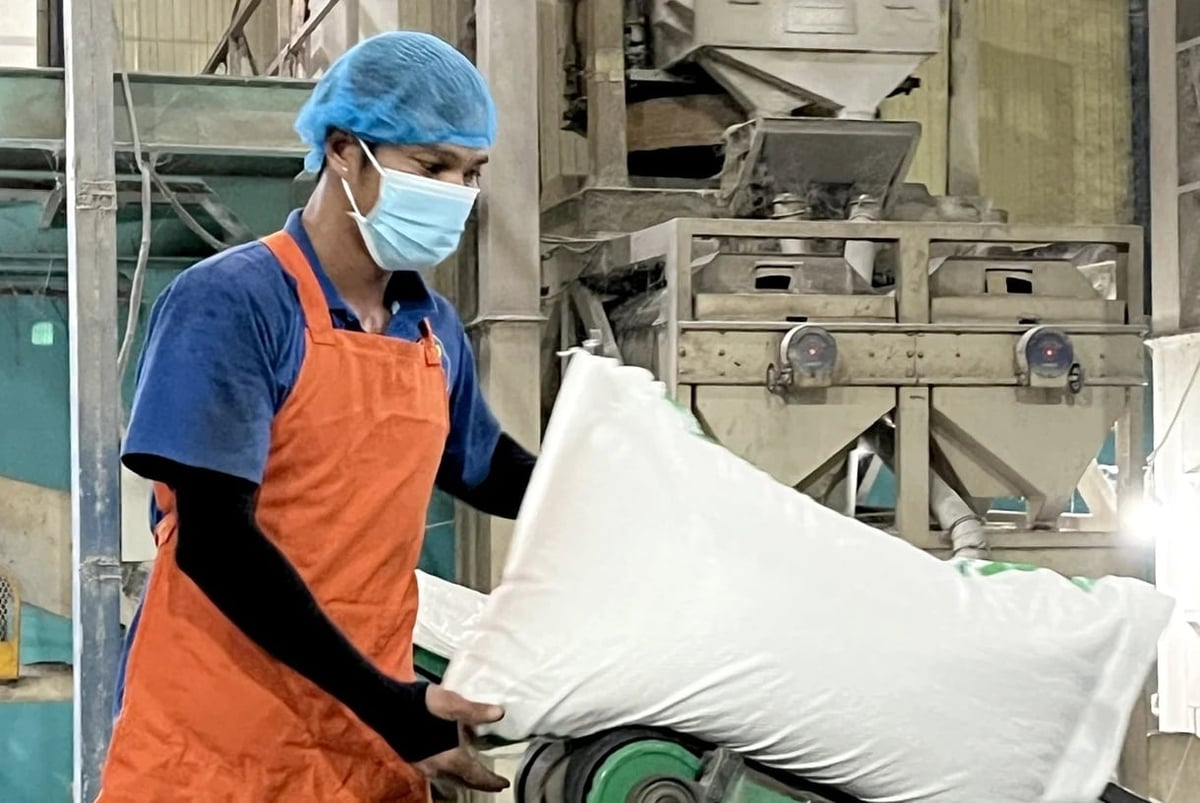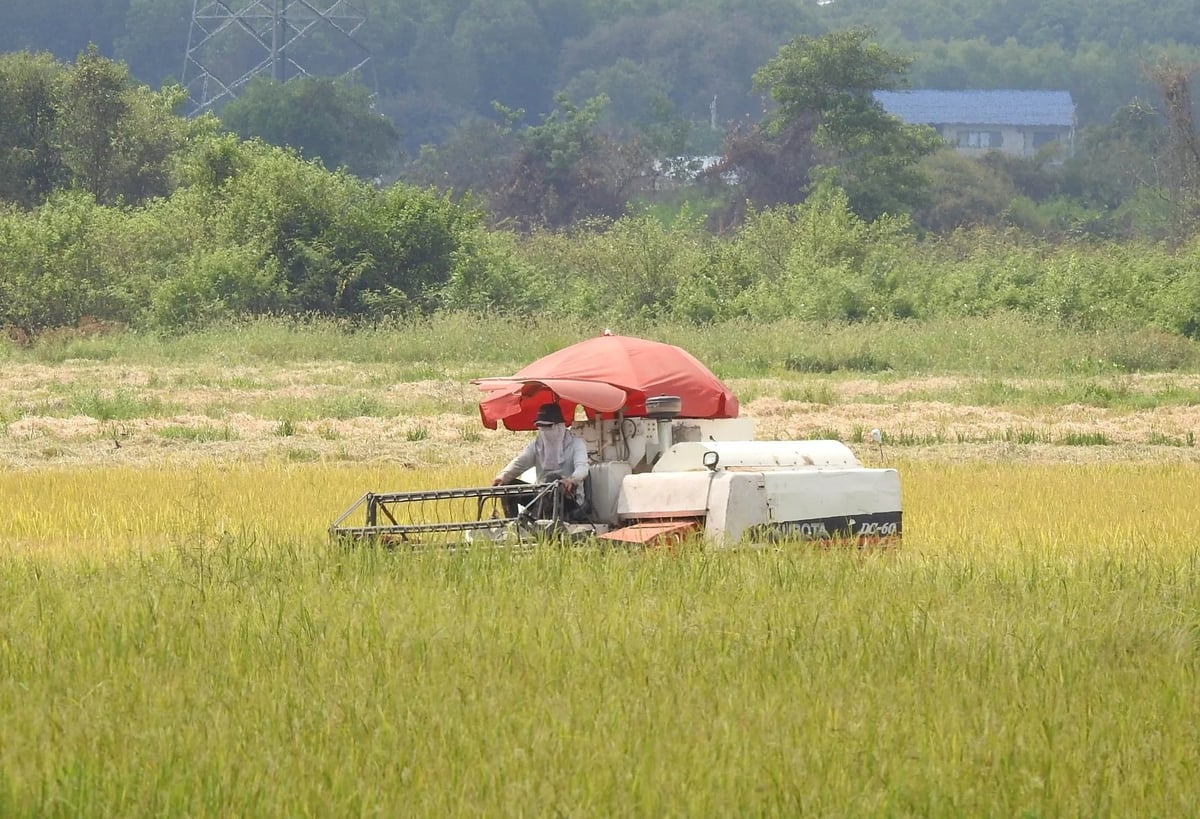November 19, 2025 | 06:11 GMT +7
November 19, 2025 | 06:11 GMT +7
Hotline: 0913.378.918
November 19, 2025 | 06:11 GMT +7
Hotline: 0913.378.918

Packing rice for export at the factory of Phuoc Thanh II Company Limited, Long An province. Photo: Son Trang.
By mid-March, rice farmers in Long An were actively harvesting their winter-spring crop. According to the Department of Agriculture and Environment of Long An province, as of March 10, over 80,000 hectares of winter-spring rice had been harvested out of the total 242,000 hectares cultivated.
This season, favorable weather conditions have led to higher yields compared to the 2023–2024 winter-spring crop. Despite the significant drop in rice prices from the previous season, most farmers in Long An remain optimistic. Currently, long-grain rice sold directly from the field is priced at around 5,700–5,800 VND/kg, ensuring farmers still make a profit, as companies continue purchasing harvested rice.
Mr. Nguyen Van Thuan, a farmer from Hamlet 2, My Thanh Commune, Thu Thua District, Long An, shared that his family had just completed harvesting two hectares of winter-spring rice. Although prices have declined compared to 2024, after deducting expenses for fertilizer, pesticides, and labor, he still earns 600 USD per hectare. Mr. Thuan noted, “In recent years, rice consumption for farmers has been quite stable. There is no backlog after harvest since companies and factories purchase the rice immediately.”
Mr. Nguyen Tuan Khoa, Deputy Director of Phuoc Thanh II Company Limited (Long An), explained that price drops are common during the winter-spring crop due to its high yield, while importing countries take time to balance their annual rice import quotas. This year, with a strong harvest, winter-spring rice production is even higher during the peak harvest period.
Meanwhile, Mr. Do Ha Nam, Vice President of the Vietnam Food Association, attributed the sharp drop in Vietnam’s rice export prices to the Philippine government’s intervention. As Vietnam’s largest rice export market, the Philippines enforced strict pricing policies, requiring businesses to lower the cost of imported rice in an effort to control domestic rice prices.

Long An farmers harvest rice. Photo: Son Trang.
Many Vietnamese businesses are currently under pressure to sell rice. Facing demands from Philippine importers to lower prices, many companies have been forced to sell at significantly reduced rates compared to 2024, causing a sharp drop in Vietnam’s overall rice export prices.
Meanwhile, other rice-exporting countries, which are less reliant on the Philippine market, have not experienced such a steep decline in prices. However, Vietnam’s lower export prices have indirectly influenced the global market, leading to price drops in Thailand, Myanmar, and other rice-exporting nations.
After a period of sharp decline, Vietnam’s rice export prices are now showing signs of stabilization. By mid-March, Vietnam’s 5% broken rice was trading at over 390 USD per ton.
Mr. Nguyen Tuan Khoa believes that importers will eventually resume buying Vietnam’s winter-spring rice due to its good quality and competitive pricing. Recognizing this trend, and with domestic rice prices having fallen significantly, Vietnamese companies and factories are increasing their purchases to prevent further price declines.
Mr. Do Ha Nam warned that if domestic rice prices continue to drop, it could negatively impact farmers’ incomes. This, in turn, may lead farmers to reduce investment in future crops or even switch to other crops with higher economic returns. To maintain stability, businesses must carefully plan and coordinate purchases to ensure rice prices remain profitable for farmers.
According to Do Ha Nam, the recent sharp decline in Vietnam’s rice export and paddy prices is only a temporary phenomenon. Many international markets are accustomed to using Vietnamese rice, making it unlikely that they will completely switch to suppliers from other countries. The key challenge is finding a reasonable price point that ensures profitability for rice growers, Vietnamese exporters, and price acceptance in importing countries. Based on market conditions, the optimal price for 5% broken rice exports should be 500 USD per ton.
In the first months of 2025, global rice trade has fluctuated as world supply is becoming surplus. Import demand of countries around the world is decreasing, with no signs of recovery in the short term, major import markets are cautious in stockpiling and purchasing rice.
Domestically, the provinces in the Mekong Delta are harvesting the winter-spring rice crop, so the rice purchase price has decreased significantly compared to the same period in 2024.
The Ministry of Agriculture and Environment stated that the volume of rice exported in February was estimated at 560 thousand tons, worth 288.2 million USD. In the first two months of the year, Vietnam exported 1.1 million tons of rice, worth 613 million USD, up 5.9% in volume but down 13.6% in value compared to the same period in 2024.
Translated by Quynh Chi

(VAN) 'If we can address disease challenges and properly plan farming zones, Vietnamese shrimp can absolutely rise to lead the world,' Mr. Le Van Quang affirmed.

(VAN) The year 2025 continues to mark a significant footprint for Chanh Thu Fruit Import-Export Group Joint Stock Company (Chanh Thu Group) in the international market.

(VAN) Participating in the exhibition celebrating the 80-year tradition of the Agriculture and Environment sector, Dong Giao Food Export Joint Stock Company (DOVECO) showcased a range of products utilizing new technologies.

(VAN) Vietnam’s pepper export turnover in the first 10 months of 2025 reached $1.39 billion, already surpassing the full-year figure of 2024.

(VAN) AGRITECHNICA 2025 has impressively reaffirmed its position as the world’s leading trade fair for agricultural machinery.
/2025/11/17/4947-2-104601_225.jpg)
(VAN) The international market is growing rapidly, creating major opportunities for Viet Nam's tilapia industry.
/2025/11/17/1234-2-010716_981.jpg)
(VAN) Deputy General Director of Viet Nhat Group Nguyen Dang Ngoc shared experiences on building linkage chains and developing sustainable tilapia farming that meets international standards.